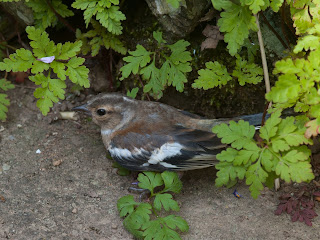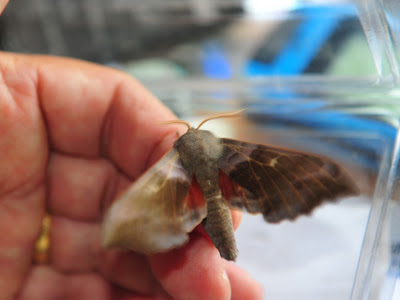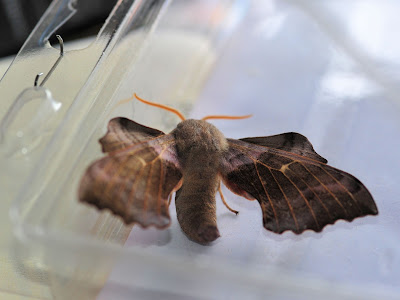Sunday, June 30, 2013
meadow life
for the first time this year the butterflies are stirring in the meadows. There were dozens of meadow browns (top) and skippers (middle) and the occasional ringlet (bottom), but no sign yet of the bigger and more colourful species, and no painted ladies.
Labels:
butterflies,
Inny valley,
meadows
Harriet's house
Our martins continue to do well behind the sparrow barrier. Meanwhile swallows have built a nest in the porch of our neighbours and it is now full of hungry mouths. The nest is very similar to a martin's nest but more coarsely built and with much wider access making it much easier for the adults to fly in and out.
Labels:
birds
Wednesday, June 26, 2013
Flutters and flies
A juvenile chaffinch showing the subtle colouration in the feathers. Unfortunately this juvenile is injured in some way and is unable to do more than flutter away. Below is a hoverfly, one of 276 species identified in Britain but impossible to identify (I think) on the wing.
Labels:
birds,
insect life
Tuesday, June 25, 2013
Monday, June 24, 2013
more from the bee's eye view
one of the smaller flowers in the meadows is eyebright (above), and like everything else this year bastard balm (below) is flowering very late. It is noticeable how similar the basic structure of these meadow flowers is, with a landing pad, and colour coded docking sites.
Labels:
flora,
Greenscoombe
bee's eye view
Labels:
flora,
Greenscoombe
Sunday, June 23, 2013
red flags
No further comment required ? The new robber barons are enclosing the land, and the peasants can go starve. Be a banker, or a lawyer, make your money gambling with other people's money, contribute nothing, manufacture nothing, use their money to buy their land, hunt, shoot and fish. Just keep them out. Power only speaks to money.
Labels:
Carthamartha,
dogatribe
beetle mania
we came across this group of dor beetles on a track in the conifer woods near Carthamartha. There was no obvious evidence of droppings and the beetles seemed to be producing the moist mud balls by themselves. Some beetles had paired off and were burrowing deeper. Very faint stridulations were audible. Is this common behaviour and what were they doing? I have posted these pictures on Wild about Britain where someone will definitely be able to provide an answer. I feel fairly sure they are mating but I have never seen a collection of these beetles like this before (a colony seems to be the correct collective noun).
Saturday, June 22, 2013
Marting about
In this picture there are at least seven martins flying around this funny little meadow opposite our paddock. Even though it is a dreary, windy, rainy day there were many more very excited birds darting about. I have no idea what they were hunting but they were protected from the wind and rain by a stand of large sycamores. They are very hard to capture on the move in this sort of light.
Friday, June 21, 2013
Ascendant
There is nothing quite like the sound of a skylark, but even with 20/20 vision, an excellent camera and a telephoto lens they are still difficult to see (top picture) but further digital enlargement makes them a bit clearer . This skylark was singing above a field of miscanthus (elephant grass) that was cropped recently so maybe they can use these otherwise barren fields to nest in.
Labels:
birds
Thursday, June 20, 2013
Martinot line update
So far so good. After some hesitation, the martins have completed one nest and are well on the way to finishing the second nest. It sounds as if a martin is sitting in the nest on the right. The pesky (but much loved and well fed) sparrows have not tried to take over the nest or intimidate the martins yet, but we may have to risk life and limb to extend the Martinot line along to the corner of the eaves because as history shows the enemy can always go round the the undefended corner at the top.
Tuesday, June 18, 2013
bullfinch fat ball
who's calling me fat? Female bullfinch and sparrow together. Possibly a young bullfinch as they seem to be breeding nearby.
Labels:
birds
popular picture
This handsome and chubby moth is the poplar hawk moth. Normally it flies at night and rests up during the day. The flashes of red brown at the base of the hind wing are characteristic, as is the generally pale brown grey colour of the fore wings. This moth trembled a lot presumably as a defence display, and it was happy to fly off when finally released. It also has the unusual habit of holding its hindwings in front of its fore wings when at rest as can be seen below. It is the commonest of our hawk moths. Although it has a proboscis, the adults do not feed.
Labels:
insect life,
moths
Monday, June 17, 2013
It was warm and sunny today. Bees were out in large numbers (but no butterflies) and it feels like the year is finally back on its proper trajectory. It is sumptuously green.
Labels:
scenic
in the elephant grass
Good to see that something can eat miscanthus other than power stations. A female roe deer who didn't sense us as we approached.
Labels:
wildlife
Friday, June 14, 2013
there's nothing like a Dame
this tall plant in our paddock is called dame's violet. It is related to mayflower, honesty and the stock family and has a lovely gentle scent. I have no idea where it came from (it is a native plant) but the name apparently refers to Damascus and not to women.
Labels:
flora
Spot, the rabbit
Both the rabbit and Spot remained stock still for 5 minutes, each waiting for the other to make the first move thus creating the first standoff of hispanic origins in Venterdon history. Rabbit is relying on Spot proof glass barrier (he does occasionally try and hurl himself through it thus demonstrating that the lurcher is no brighter than the fly).
Labels:
dogs
Sunday, June 09, 2013
Still no nuts
Our walnut tree, planted on Good Friday 1999, in keeping with everything else this year is way behind and is only now coming into leaf. This is the first catkin (male flower) it has ever borne, unfortunately whereas previously it has only produced female flowers this year there are none to be seen. Still no walnuts!
wending in the willows
the Inny at its greenest, and a female wide bodied chaser (or libellula) freshly emerged and drying off in the sun
Saturday, June 08, 2013
sparrow fence
It turns out that sparrows are well know for bullying martins. On the advice of the RSPB (see link) we have made a sparrow barrier out of odds and ends. We shall watch developments with interest.
Labels:
home
Thursday, June 06, 2013
martinville
Somewhat later than usual the martins have returned. Looking back through the records on this blog they are at least two weeks and up to six weeks later than usual. Recently they have taken to arriving and then disappearing for a few weeks, no doubt to fatten up for the breeding season. I am not sure that these two have decided to nest here. They spend a lot of time chattering to each other and flying around just like a married couple looking for a new home to start a family. Almost immediately a male sparrow appeared on the guttering above which does not bode well for a peaceful few weeks.
Wednesday, June 05, 2013
brimstone and fire
Apart from a few small whites there really are very few butterflies around at the moment. I don't know whether they are simply late because of the cold weather this Spring, or absent because of last year's dismal weather. However, there are some brimstones in the woods. These are very fidgety butterflies. When a male and a virgin female meet they perform a spiral dance up into the canopy, whirling around feverishly before falling to the ground (in a swoon?) to mate (see link). In this photo the female is above the male who is obviously much more yellow. It makes a very attractive sight in the yellowish light under the emerging canopy.
Labels:
butterflies
Tuesday, June 04, 2013
white wing
I thought I saw this young rook before we left when it was struggling to fly. I have never seen markings like this on a rook before and I don't know whether it is some form of partial albinism or the result of an injury, but it is very striking. As always somewhere on the net there is more information (see link) !
Labels:
birds
Home again
Alaska was stunning with its beautiful blues, whites and greys but there is something incomparably beautiful about the green landscape of England and especially Cornwall as it blossoms in late Spring.
Subscribe to:
Posts (Atom)











































